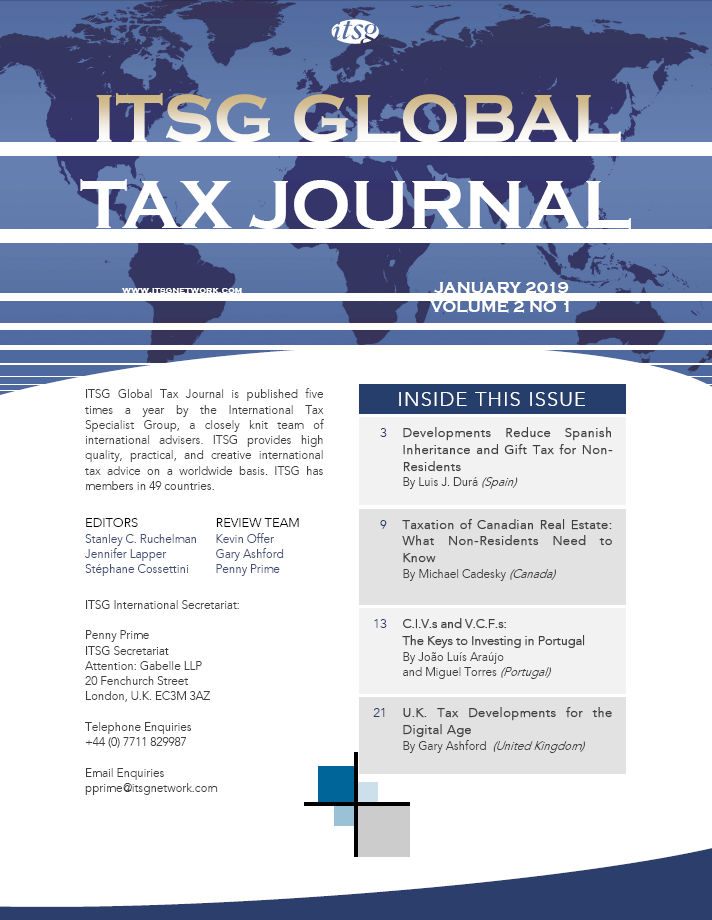The world has changed, and tax authorities find that new rules are required to accomplish old tasks. Existing tax systems applying domestic tax rules to cover international taxation were created at a time when international trade principally meant production of a physical product in one country that was shipped by vessel to a market overseas. These systems have become obsolete as value drivers in trade now focus on state-of-the-art intellectual property (I.P.) that can be transferred to ten different locations in less time than it took to read this sentence. Now, we are seeing governments and tax authorities introducing new rules to counter the perceived, and often real, inappropriate enjoyment of benefits by international digital businesses and to bring the law in line with the increasing digitalisation of the traditional economy.
This is certainly the case in the U.K. Statistics show that the U.K. has the greatest percentage of online retail shopping in Europe. As of 2017, the percentage of online retail sales in the U.K. was 17.8% of total trade, steadily up from a figure of 13.5% in 20141. In comparison, online retail sales in Italy amounted to 3.4% of total trade in 2017, which was up from 2.1% in 2016. On a world basis, the U.K. is third, behind only China and the U.S.2
The U.K. government and H.M.R.C., the U.K. tax authority, are focused on countering tax imbalances between international digital businesses and more traditional, often domestic, brick-and-mortar businesses. The international community is also working to address many of the same challenges. For example, we saw the Organisation of Cooperation and Development (O.E.C.D.), set up the Base Erosion and Profit Shifting (B.E.P.S.) initiative in 2012, which published 15 findings and recommendations (Actions) in 2015. Many Actions are being adopted by tax authorities globally, including H.M.R.C. We have also seen the European Commission (the Commission) take action with the implementation of the E.U. Anti-Tax Avoidance Directive (A.T.A.D.). Separately, the U.S. has updated its tax code with various amendments in this area through the introduction of B.E.A.T., G.I.L.T.I., and anti-hybrid provisions.
This article looks at some of the International challenges but also at changes and potential proposals introduced in the U.K. to address this new, developing, and increasingly digitised world.
The B.E.P.S. initiative
As stated above, the O.E.C.D., as well as the G-20 countries, set out in 2012 to look at the challenges of the digital economy and the challenges produced more generally by the current international tax model.
Over a short period, findings were introduced by way of the 15 B.E.P.S. Actions:
| Action 1 | The Digital Economy |
| Action 2 | Hybrid Mismatches |
| Action 3 | C.F.C. rules |
| Action 4 | Interest Deductions |
| Action 5 | Harmful Tax Practices |
| Action 6 | Treaty Abuse |
| Action 7 | Permanent Establishment |
| Actions 8-10 | Transfer Pricing |
| Action 11 | B.E.P.S. Data Analysis |
| Action 12 | Disclosure of Aggressive Planning |
| Action 13 | Transfer Pricing Documentation< |
| Action 14 | Dispute Resolution |
| Action 15 | Multilateral Instrument |
Most members of the O.E.C.D. have implemented the recommendations in whole or in part. The U.K. already had rules for many of the Actions, such as C.F.C.s, transfer pricing, and permanent establishments (P.E.s). In relation to other Actions, the U.K. has introduced rules around hybrid mismatches and interest deductions. Interest expense deductions will generally be limited to 30% of EBITDA where interest expense exceeds £2 million.
B.E.P.S. Action 1
B.E.P.S. Action 1 addressed issues arising from the digital economy. On 16 March 2018, the O.E.C.D. published “Tax Challenges Arising from Digitalisation – Interim Report 2018”. This report sets out an O.E.C.D. Inclusive Framework-agreed programme and a direction of work on digitalisation and international tax rules through to 2020.
The report determined that technological advances have brought about a rapid decline in the unit cost of data processing, leading to dramatic increases in the use of digital information which can be manipulated at high speeds and low marginal costs. This change has facilitated the adoption and integration of digital products and transactions, inducing an ongoing, structural transformation of the economy. As a result, the structure of businesses and the process of value creation have evolved significantly. The report identified the most salient, common characteristics of digitalised businesses. These characteristics, which may become common features of an even wider number of businesses as digitalisation continues, include: (1) cross-jurisdictional scale without mass; (2) reliance on intangible assets, including I.P.; and (3) data, user participation, and their synergies with I.P.
Cross-jurisdictional scale without mass
The interim report explains the ways by which digitalisation has allowed businesses to locate various stages of production processes across different countries, whilst at the same time accessing a greater number of customers around the globe. It states that digitalisation allows highly digitalised businesses to be heavily involved in the “economic life” of a country without any “significant presence” in that country.Reliance on intangible assets, including I.P.
According to the interim report, digitalised enterprises are characterised by the growing importance of investment in intangibles, especially I.P. assets, which could either be
owned by the business or leased from a third party. For many digitalised enterprises, the intense use of I.P. assets, such as software and algorithms supporting their platforms, websites, and many other crucial functions, are central to their business models.Data, user participation, and their synergies with I.P.
According to the report, data, user participation, network effects, and the provision of user-generated content are commonly observed in the business models of more highly digitalised businesses. The benefits from data analysis are also likely to increase with the amount of collected information linked to a specific user or customer. The important role that user participation can play is seen in the case of social networks, where without data, network effects, and user-generated content, the businesses would not exist as we know them today. In addition, the degree of user participation can be broadly divided into two categories: active and passive. However, the degree of user participation does not necessarily correlate with the degree of digitalisation. For example, cloud computing can be considered as a more highly digitalised business that involves only limited user participation.
Whilst participating O.E.C.D. members agree on the characteristics of digitised business models and have established a programme to continue examining the issue, no consensus exists regarding the location of the value creation or the identity of the value creator. In the absence of consensus, many countries, including the U.K., are pressing ahead with interim taxing methods. The U.K. government believes that the way in which highly digitised businesses derive value from user participation is the fundamental challenge to the historic model of cross-border business taxation. As a result, it introduced the diverted profit tax in 2015 and proposes to introduce additional taxes on digital sales to U.K. customers.
B.E.P.S. Action 5
B.E.P.S. Action 5 looked at harmful tax practices and, in particular, rules relating to the taxation of intangibles. Many countries, including the U.K., already offered regimes for taxing profits of a corporation arising from patent income at a lower rate. The U.K. patent box regime, for example, taxed profits from qualifying patents structured as royalties or embedded within sales income at a reduced rate of 10% (less than 53% of the current rate of U.K. corporation tax of 19%).
Action 5 recommended close alignment between these regimes and underlying research and development (R&D) activity. In line with the recommendation, the U.K. introduced changes to its patent box regime in 2016. Qualifying income from patents remains taxed at the 105% rate but, in line with Action 5, the U.K. adopted the “modified nexus” rule, which requires tracking of R&D activity and differentiating between R&D activity carried out by the company claiming the relief and R&D which has been outsourced.
B.E.P.S. Action 7
Regarding P.E.s (Action 7), the U.K. announced that it will conform its P.E. rules to the O.E.C.D. recommendations.
In the meantime, several jurisdictions have sought to introduce local, short-term solutions to the issue of overseas media and tech businesses selling services within the particular jurisdiction and often paying little tax because of the absence of a P.E., notwithstanding substantial sales to thousands of customers. Both the E.U. and the U.K. are looking to introduce a form of digital sales tax, based in part around the interaction of the website and users in the country where “sales” occur.
U.K. Diverted Profits Tax (D.P.T.)
The U.K. introduced the D.P.T. (known colloquially as the Google tax) on 1 April 2015 by way of Finance Act 2015. The D.P.T. is intended to apply to two broad situations:
- The first situation involves a foreign company that structures its arrangements to avoid creating a U.K. P.E. Several thresholds must exist before the D.P.T. applies. One is that the foreign company must generate more than £10 million annually in U.K.-related sales revenues from the supply of goods, services, or other property. A second is that the foreign company must incur more than £1 million in U.K.-related expenses.
- The second situation involve entities or transactions involving affiliated parties that lack economic substance. Here the transaction must involve either a U.K.-resident company or a U.K. P.E. of a foreign company that is part of an arrangement designed to exploit tax mismatches.
In general, profits chargeable to U.K. taxes are subject to transfer pricing rules under Section 147 TIOPA 2010. Under that provision, tax law calculations are to be based on arm’s length principles where there is a participation relationship between two persons. Where the transaction value yields to a result that is not-arm’s length in amount, an adjustment is required to reflect arm’s length principles. The result of any transfer pricing adjustment is a potential adjustment in the company’s tax return.
The aim of the D.P.T. is to apply in those cases where the transfer pricing adjustment is insufficient or there is some sort of recharacterisation of the arrangements. In those circumstances, the D.P.T. is applicable on a just and reasonable basis.
The rules are intended to apply only to large enterprises and not to small- or medium-sized enterprises (S.M.E.s). S.M.E.s broadly comprise enterprises employing globally fewer than 250 persons, an annual global turnover not exceeding €50 million, and an annual balance sheet not exceeding €43 million in assets. It is important to appreciate that the D.P.T. can still apply if there is one large company and one S.M.E. Note that the rules are not limited to transactions or arrangements within tax havens or low-tax jurisdictions but can apply more broadly. If the D.P.T. applies, any D.P.T. adjustment will be taxed at 25%, which exceeds the current corporation tax rate of 19%.
H.M.R.C. has set up D.P.T. investigation teams and these teams have already secured significant returns. Figures released in September 2017 show that application of the D.P.T. raised £281 million in the tax year 2016/17, of which about half arose from 14 D.P.T. charging notices. D.P.T. is moving into a new phase within the U.K., and H.M.R.C. anticipates raising £200 million in 2017/18 and £300 million in each of the following two years.
H.M.R.C. recently announced a temporary voluntary disclosure program for companies that have participated in diversion schemes. It will run through December 31, 2019. In principle, participants will be viewed to make unprompted disclosures, which should lower penalties.
New U.K. tax on offshore intangible income linked to U.K. sales
In the 2017 Budget, the U.K. government set out their intentions to find a way to tax royalty income of offshore companies where a direct or indirect link exists to U.K. sales. The legislation is included in Finance Bill 2019.
The tax is currently in the consultation stage within the U.K. It will apply from 6 April 2019 and will have the effect of imposing U.K. income tax on the owners of intangible property or those that are entitled to intangible property income that is linked to the sale of goods or services in the U.K.
A safe harbour is to be provided if all the following facts can be established:
- The value of U.K. sales is less than £10 million in a given tax year.
- Substantially all, of the business activity in relation to the intangible property historically has taken place in the territory of residence of the company generating intangible income.
- The tax actually paid on the intangible income is at least 50% of the U.K. income tax that would otherwise arise under this measure.
Several proposed administrative rules are designed to ensure collection of the tax. Joint and several liability will exist for the income tax charge among the members of the control group that contains the foreign company generating the royalty income. Targeted anti-avoidance rules are proposed to ignore arrangements entered into on or after 29 October 2018.
These proposed changes will exist side-by-side with current provisions that were adopted in Finance Act 2016. Those provisions were not specifically targeted to the digital economy but had the effect of broadening the U.K. withholding tax rules on payments of royalties to owners overseas.
New U.K. Digital Services Tax (D.S.T.)
In the 2018 Budget, the U.K. government announced the introduction of the D.S.T. This is a new tax which seeks to protect the U.K. tax base whilst in principle recognises the international tax rule that multinational groups should be taxed only on profits derived from activities undertaken and value generated within the jurisdiction. The tax will apply from April 2020 and the legislation will be included in the U.K. Finance Bill for 2019/20. A Consultation document was released by HM Treasury and H.M.R.C. in November 2018. The D.S.T. will apply a 2% tax on revenues of specific digital business models linked to the participation of U.K. users. The tax will apply to search engines, social media platforms, and online marketplaces. The U.K. government estimates that the D.S.T. will raise £1.5 billion over four years.
The government states that the D.S.T. will only apply to the revenues that are attributable to business models linked to U.K. users. What matters is the location of the user, not the location of the business. Certain fact patterns illustrate the scope of the D.S.T.:
- A social media platform generates revenues from targeting advertisements at U.K. users.
- A marketplace generates commissions by facilitating a transaction between U.K. users.
- A search engine generates revenues by displaying advertising keyed by search terms input by U.K. users.
The D.S.T. will apply only to large businesses. To come within its scope, the consultation document provides that a business must generate more than £500 million in annual global revenue from targeted business activities. Once that condition is met, the tax will apply only to annual revenue from targeted business activities linked to the participation of U.K. users. The first £25 million of business revenue will be exempt. Businesses will be entitled to make an alternative calculation of their D.S.T. liability when the model produces low profit margins. The D.S.T. will be deductible against a company’s corporation tax but will not be creditable.
The proposed E.U. Digital Services Tax
The Commission has developed two proposals that achieve goals that are similar to those of the D.S.T. The first proposal aims to reform corporate tax rules so that profits are registered and taxed where businesses have significant interactions with users through digital channels. This is the preferred long-term solution of the Commission. The second proposal responds to requests from several Member States for an interim tax which covers the main digital activities that currently escape tax altogether in the E.U.
Common corporate tax rules for digital activities
The Commission states that this proposal would enable Member States to tax profits that are generated in a territory in the absence of physical presence. Under the proposals, a digital platform will have a taxable digital presence or a virtual P.E. in a Member State if it meets any one of certain criteria:
- The digital platform generates more than €7 million in annual revenues in a Member State.
- The digital platform has more than 100,000 users in a Member State in a taxable year.
- The digital platform generates 3,000 business contracts for digital services between the company and business users in a taxable year.
The Commission contends that the potential changes will modify the way profits are allocated to Member States. The goal is to better reflect how companies create value online. In this way, the goal of the proposal is similar to the U.K. D.S.T. in that it attempts to link the right to tax to the location of users at the time of consumption.
Interim tax on certain revenue from digital activities
As an interim measure, the Commission has proposed an indirect tax that will apply to revenues created from activities where users play a major role in value creation. The term “indirect tax” connotes a tax on gross sales revenue with no relief provided for cost of goods sold or operating costs. The interim tax will apply to revenue generated in the following circumstances:
- Revenue created from selling online advertising space.
- Revenue created from digital intermediary activities which allow users to interact with other users and which can facilitate the sale of goods and services between them. (EBAY is an example.)
- Revenue created from the sale of data generated from user-provided information.
The rate of tax being proposed is 3%, which exceeds the U.K.’s own 2% proposal. The tax will apply only to companies with total annual worldwide revenues of €750 million or more, including E.U. revenues of at least €50 million.
U.K. anti-profit fragmentation rules
The U.K. government has proposed a new set of rules designed to attack schemes that fragment profits in an abusive way. The changes will amend the territorial scope set out within Section 6 of Income Tax (Trading and Other Income) Act 2005 (I.T.T.O.I.A.) or Part 3 Corporation Tax 2009 (C.T.A.).
The proposals are intended to be effective from April 2019. The purpose of this legislation is to prevent U.K.-resident businesses and professional firms from avoiding U.K. tax by arranging for U.K.-source business profits to accrue to entities resident in territories having significantly lower tax rates that those imposed in the U.K. This will exist when tax paid abroad on a portion of business directed to the U.K. is less than 80% of U.K. tax. For corporations, the current tax rate in the U.K. is 19%. Consequently, the proposal attacks fragmentation plans of corporations that allocate profit to a jurisdiction which imposes tax at a rate of less than 15.2% when the computation of income in the U.K. and the other jurisdiction is computed without material differences. If a business or profession is carried on in partnership form and the members are individuals, the target rate will be much higher, reflecting the graduated rates of tax imposed on individuals.
Currently, profits of a trade arising to a U.K. resident are chargeable to U.K. tax wherever the trade is carried on. Also, profits of a trade arising to a non-U.K. resident are chargeable to U.K. tax only if they arise from a trade carried on wholly or partly in the U.K. In the latter case, the profits from the part of the trade or professional activity carried on in the U.K. is subject to tax.
The new legislation will apply when a set of specified factors exist:
- There is a transfer of value from a U.K. trader to an offshore entity. (This could arise from a diversion of income or payment of expenses to an offshore entity.)
- The effect of the arrangement is that a significantly lower level of tax is paid on the profits than would be the case if properly taxed in the U.K. in the absence of the arrangement.
- The proprietor of the business, whether a sole trader or partner in an unincorporated business, or director and/or shareholder of a company can enjoy the profits that have been diverted.
- The U.K. person has arranged for the profits to be diverted to the offshore entity.
- The diversion or payments are not commensurate with the work undertaken by the offshore entity.
The legislation applies only where it is reasonable to conclude the relevant arrangements were entered into to obtain a tax advantage. Where the new legislation is applicable to a U.K. business, taxpayers will be required to notify H.M.R.C. of relevant arrangements meeting certain criteria within their tax returns. Where all factors exist and the prohibited tax-saving intent exists, the arrangement is counteracted by bringing the profits back into U.K. tax by attributing the correct amount of profits to the U.K. business or professional activity.
Personal Services Companies (P.S.C.s)
The U.K. has seen a significant increase in the number of individuals operating in the U.K. through P.S.C.s. This phenomenon was first apparent shortly after H.M.R.C. introduced the off-payroll working rules known as IR35.
These rules attempt to ensure that people working through a P.S.C. who would have been employees if they had been engaged directly, pay broadly the same income tax and national insurance contributions as would be paid if they were employed. The provisions of IR35 were largely unsuccessful. H.M.R.C. estimated that prior to 2017, only 10% of individuals working in this way applied the rules properly, costing the government millions of pounds in lost tax revenues every year.
In April 2017, the government reformed these rules for engagements in the public sector. As a result, a public authority must decide whether the off-payroll working rules apply because the appropriate conditions have been met. If so, it must deduct income tax and national insurance contributions from a payment to a P.S.C. If the worker is paid by an agency or other labour provider, a public authority must advise the agency that pays the worker that the off-payroll working rules should apply.
For purposes of the off-payroll rules, a public authority is defined by the Freedom of Information Act 2000 and the Freedom of Information (Scotland) Act 2002. Included are government departments and their executive agencies, companies owned or controlled by the public sector, schools and universities, local authorities, and the National Health Service.
In the Autumn Budget 2017, the government announced it would consult on how to tackle non-compliance with the off-payroll working rules for workers in the private sector. This was followed by a consultation document on 18 May 2018, in which H.M.R.C. and HM Treasury sought private sector input in drafting the provision. As part of the request, an example of the abusive tax structuring was provided to illustrate the scope of the issue:
ILLUSTRATIVE EXAMPLE 1: The non-compliant off-payroll project manager Charlie is a project manager working through a limited company (his own P.S.C.). A private sector company, ABC Ltd, contract with Charlie’s P.S.C. from 6 April 2018 to 5 April 2019. Charlie’s working practices are such that he would be an employee of ABC Ltd if he contracted directly with them. Charlie’s P.S.C. charges ABC Ltd £50,000 for his services, and his P.S.C. is not registered for VAT. Charlie follows a typical strategy, paying himself an income tax and N.I.C.s efficient salary. Charlie’s P.S.C. pays corporation tax on the remaining payment from ABC Ltd; and he then chooses to distribute all remaining income from the work to himself as dividends. Charlie personally pays £2,119 in income tax. Charlie’s P.S.C. pays £7,899 in corporation tax. The total income tax and corporation tax paid would be £10,018.
Charlie is not currently compliant with the off-payroll working rules.
However, if Charlie was compliant, the total income tax and N.I.C.s (including employer N.I.C.s) due on the payment from ABC Ltd would be £15,041, having taken into account a 5% expenses deduction allowable under the off-payroll working rules in the private sector. As a result of Charlie’s non-compliance on this engagement £5,023 less tax is paid. Charlie has not paid any N.I.C.s as the salary he has paid himself is at the same level as the primary/secondary N.I.C.s threshold.
Thomas is an employee of ABC Ltd, doing the same job as Charlie. Employing Thomas also costs ABC Ltd £50,000 a year, in salary and Employer N.I.C.s. The total income tax and N.I.C.s due (including employer N.I.C.s), from Thomas and ABC Ltd is £16,047. This means that, despite Charlie and Thomas doing the same job, the total income tax and N.I.C.s paid is £13,928 less as a result of Charlie’s non-compliance. When corporation tax payments by Charlie’s P.S.C. are taken into account the total tax and N.I.C.s lost is £6,029. Both ABC Ltd for Charlie’s services and Charlie pay less.
In addition, the U.K. has recently introduced a targeted anti-avoidance rule aimed at limiting the opportunity for those who wind up companies and seek to extract funds as capital distributions payments of compensation. The provision is aimed at eliminating employee owned businesses from being liquidated in a transaction that provides owners with the benefit of 10% capital gains tax under the entrepreneur’s relief provision that is applicable to the liquidation distribution if the liquidation is followed by the formation of a new company that carries on the same business with the same personnel. Were the company to have remained in existence and paid a dividend, the tax on the dividend distribution would be significantly greater than the tax on the capital gain when the entrepreneur’s relief is claimed; dividends can be taxed at rates up to 38.1%.
The targeted anti-avoidance rule will have an impact on many workers in the digital economy who work through a P.S.C.
Summary
The timeline for a product to go from life-changing status to obsolescence is constantly shrinking. Think of a Palm Pilot with a stylus, a video tape player, an iPod, a Wang Machine for word processing, or an e-mail account that required a monthly fee. In short, we live in interesting times. One effect of these massive changes is that value is separated from bricks, mortar, and heavy industry. In their place, IP-embedded sales of data, delivery of digital products from a base in the cloud, and virtual marketplaces allowing businesses to access a global customer base are able to generate huge sums of profit with no physical presence in any particular state. It should come as no surprise that governments are wrestling to modernize tax rules to match new business models.
The U.K. has taken steps to address this body of stateless entrepreneurs who profitably serve customers in the U.K. More and more income that was thought to be based at the place of residence of the entity carrying on the business is now being characterized as having a U.K. component. Whether the new tax in the U.K. takes the form of the D.V.P. or the D.S.T., IR35, or the anti-fragmentation rules, change has arrived.
1 Statisa, the Statistics Portal, https://www.statista.com/statistics/281241/online-share-of-retail-trade-in-european-countries/.
2 Id., at https://www.statista.com/statistics/274493/worldwide-largest-e-commerce-markets-forecast/.

 Login
Login





















































